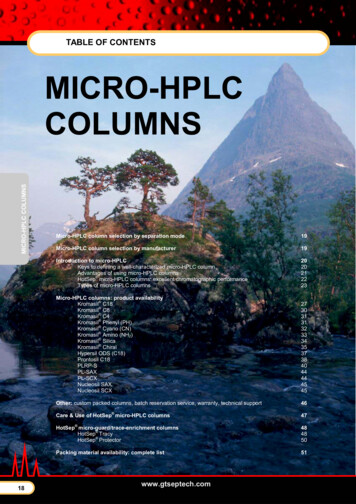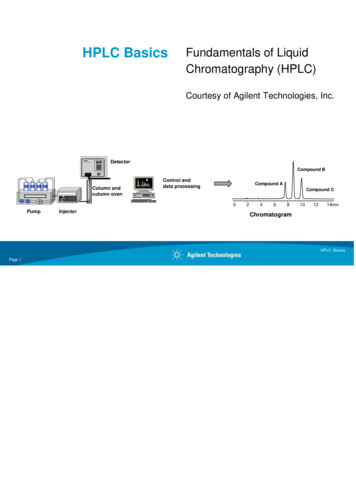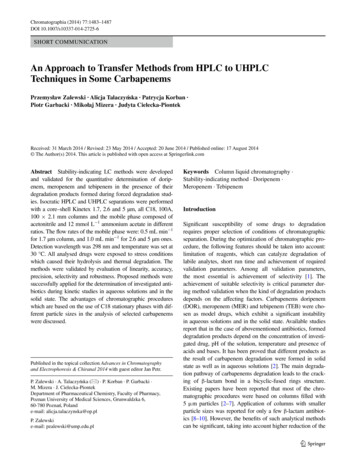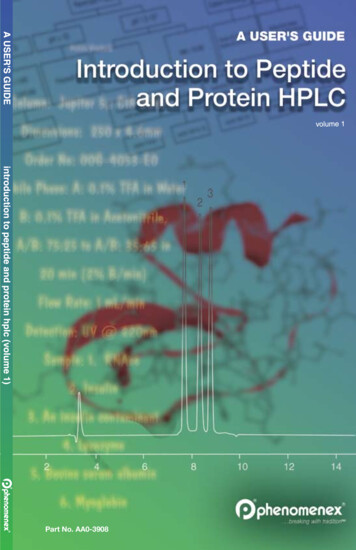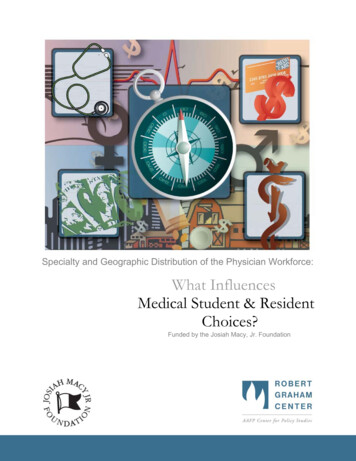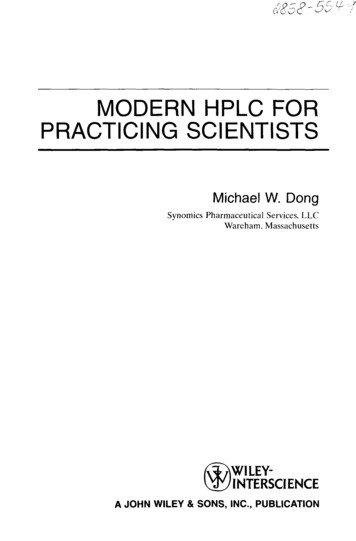
Transcription
MODERN HPLC FORPRACTICING SCIENTISTSMichael W. DongSynomics Pharmaceutical Services, LLCWareham, MassachusettsWILEYINTERSCIENCEA JOHN WILEY & SONS, INC., PUBLICATION
CONTENTSPrefacexv1 Introduction1.11.21.31.41.51.6Introduction / 11.1.1 Scope / 11.1.2 What Is HPLC? / 21.1.3 A Brief History / 31.1.4 Advantages and Limitations / 4Modes of HPLC / 51.2.1 Normal-Phase Chromatography (NPC) / 51.2.2 Reversed-Phase Chromatography (RPC) / 71.2.3 Ion-Exchange Chromatography (IEC) / 71.2.4 Size-Exclusion Chromatography (SEC) / 91.2.5 Other Separation Modes / 10Some Common-Sense Corollaries / 11How to Get More Information / 12Summary / 13References / 132 Basic Terms and Concepts2.12.21Scope / 16Basic Terms and Concepts / 172.2.1 Retention Time (t R ). Void Time (tM). Peak Height (h).and Peak Width (wb) / 172.2.2 Retention Volume (VR). Void Volume (VM). andPeak Volume / 182.2.3 Retention Factor (k) / 192.2.4 Separation Factor (a) / 202.2.5 Column Efficiency and Plate Number (N) / 212.2.6 Peak Volume / 222.2.7 Height Equivalent to a Theoretical Plate or PlateHeight (HETP or H) / 2315
ViCONTENTS2.2.8 Resolution (Rs) / 232.2.9 Peak Symmetry: Asymetry Factor (As) and TailingFactor (Tf) / 242.3 Mobile Phase / 272.3.1 General Requirements / 272.3.2 Solvent Strength and Selectivity / 282.3.3 Buffers / 312.3.4 Acidic Mobile Phases / 322.3.5 Ion-Pairing Additives / 322.3.6 High pH Mobile Phase / 332.3.7 Other Operating Parameters: Flow Rate (F) and ColumnTemperature (T) / 332.4 The Resolution Equation / 342.5 The Van Deemter Equation / 352.6 Isocratic vs. Gradient Analysis / 392.6.1 Peak Capacity (n) / 402.6.2 Key Gradient Parameters (Initial and Final SolventStrength, Gradient Time [tG], and Flow Rate) / 412.6.3 The 0.25 AtG Rule: When Is Isocratic Analysis MoreAppropriate? / 422.7 Concept of Orthogonality / 422.8 Sample Capacity / 442.9 Glossary of HPLC Terms / 442.10 Summary and Conclusion / 452.11 References / 463 HPLC Columns and Trends3.13.23.33.43.5Scope / 48General Column Description and Characteristics / 483.2.1 Column Hardware—Standard vs. Cartridge Format / 49Column Types / 503.3.1 Types Based on Chromatographic Modes / 503.3.2 Types Based on Dimensions / 513.3.3 Column Length (L) / 51Column Packing Characteristics / 523.4.1 Support Type / 533.4.2 Particle Size (dp) / 543.4.3 Surface Area and Pore Size (dpore) / 543.4.4 Bonding Chemistries / 543.4.5 Some General Guidelines for Bonded PhaseSelection / 56Modern HPLC Column Trends / 573.5.1 High-Purity Silica / 5847
CONTENTS3.63.73.83.93.103.113.5.2 Hybrid Particles / 583.5.3 Novel Bonding Chemistries / 593.5.4 Fast LC / 643.5.5 Micro LC / 663.5.6 Monoliths / 68Guard Columns / 69Specialty Columns / 703.7.1 Bioseparation Columns / 703.7.2 Chiral Columns / 703.7.3 Application-Specific Columns / 70Column Selection Guides / 70Summary / 73References / 74Internet Resources / 754 HPLC Instrumentation and Trends4.14.24.34.44.54.64.7ViiIntroduction / 784.1.1 Scope / 784.1.2 HPLC Systems and Modules / 79HPLC Solvent Delivery Systems / 814.2.1 High-Pressure and Low-Pressure Mixing Designs inMultisolvent Pumps / 824.2.2 System Dwell Volume / 834.2.3 Trends / 84Injectors and Autosamplers / 844.3.1 Operating Principles of Autosamplers / 854.3.2 Performance Characteristics and Trends / 86Detectors / 87UV/VIS Absorbance Detectors / 874.5.1 Operating Principles / 874.5.2 Performance Characteristics / 884.5.3 Trends in Absorbance Detectors / 89Photodiode Array Detectors / 914.6.1 Operating Principles / 914.6.2 Trends in PDA Detectors / 93Other Detectors / 934.7.1 Fluorescence Detector (FLD) / 934.7.2 Refractive Index Detector (RID) / 944.7.3 Evaporative Light Scattering Detector (ELSD) / 944.7.4 Corona-Charged Aerosol Detector (CAD) / 944.7.5 Chemiluminescence Nitrogen Detector (CLND) / 954.7.6 Electrochemical Detector (ECD) / 9577
CONTENTS4.84.94.104.114.124.134.144.154.7.7 Conductivity Detector / 954.7.8 Radiometric Detector / 95Hyphenated and Specialized Systems / 964.8.1 LC/MS, LC/MS/MS / 964.8.2 LC/NMR / 974.8.3 Other Hyphenated Systems / 974.8.4 Prep LC and Bio-Purification Systems / 974.8.5 Proteomics Systems: Capillary LC andMulti-Dimensional LC / 984.8.6 High-Throughput Screening (HTS) and Parallel AnalysisSystems / 994.8.7 Ultra-High-Pressure Liquid Chromatography / 1014.8.8 Lab-on-a-Chip / 1014.8.9 Specialized Applications Systems / 101HPLC Accessories and Data Handling Systems / 1024.9.1 Solvent Degasser / 1024.9.2 Column Oven / 1024.9.3 Column Selector Valve / 1034.9.4 Data Handling and HPLC Controllers / 103Instrumental Bandwidth (IBW) / 104Trends in HPLC Equipment / 107Manufacturers and Equipment Selection / 108Summary / 109References / 109Internet Resources / 1105 HPLC Operation Guide5.15.25.35.4111Scope / 112Safety and Environmental Concerns / 1125.2.1 Safety Concerns / 1125.2.2 Environmental Concerns / 114Mobile Phase Preparation / 1145.3.1 Mobile Phase Premixing / 1145.3.2 Buffers / 1145.3.3 Filtration / 1155.3.4 Degassing / 116Best Practices in HPLC System Operation / 1165.4.1 Pump Operation / 1175.4.2 HPLC Column Use, Connection, and Maintenance / 1175.4.2.1 Column Use / 1175.4.2.2 Column Precautions / 118
CONTENTS5.55.65.75.85.965.4.2.3 Column Connection / 1185.4.2.4 Column Maintenance and Regeneration / 1185.4.3 Autosampler Operation / 1205.4.4 Detector Operation / 1205.4.5 System Shutdown / 1215.4.6 Guidelines for Increasing HPLC Precision / 1225.4.6.1 Guidelines for Improving Retention TimePrecision / 1225.4.6.2 Guidelines for Improving Peak AreaPrecision / 122From Chromatograms to Reports / 1235.5.1 Qualitative Analysis Strategies / 1285.5.2 Quantitation Analysis Strategies / 128Summary of HPLC Operation / 129Guides on Performing Trace Analysis / 129Summary / 132References / 132Pharmaceutical troduction / 1366.1.1 Scope / 1366.1.2 Overview: From Drug Discovery to Quality Control / 1366.1.3 Sample Preparation Perspectives in Drug ProductAnalysis / 1376.1.4 High-Throughput LC/MS in Drug DiscoverySupport / 137Identification / 138Assays / 1396.3.1 Drug Substances / 1406.3.2 Drug Products / 1406.3.3 Content Uniformity / 1426.3.4 Products with Multiple APIs and Natural Products / 1426.3.5 Assay of Preservatives / 145Impurity Testing / 1456.4.1 Trends in Impurity Testing / 148Dissolution Testing / 148Cleaning Validation / 148Bioanalytical Testing / 150Chiral Analysis / 151Case Study: HPLC Methods in Early Development / 152Summary / 153References / 155
CONTENTSFood, Environmental, Chemical, and Life uction / 1587.1.1 Scope / 158Food Applications / 1587.2.1 Natural Food Components / 1597.2.1.1 Sugars / 1597.2.1.2 Fats, Oils, and Triglycerides / 1607.2.1.3 Free Fatty Acids and Organic Acids / 1627.2.1.4 Proteins and Amino Acids / 1627.2.2 Food Additives / 1647.2.2.1 Flavors: A Case Study on HPLC Analysis ofCapsaicins / 1667.2.3 Contaminants / 1677.2.3.1 Mycotoxins / 1687.2.3.2 Antimicrobial Additives / 1687.2.3.3 Pesticide Residues / 169Environmental Applications / 1697.3.1 Listing of Important U.S. EPA HPLC Methods / 1707.3.2 Pesticides Analysis / 1707.3.2.1 Carbamates and Glyphosate / 1707.3.3 Polynuclear Aromatic Hydrocarbons (PAH) / 1727.3.3.1 Case Study: Quick Turnaround Analysis ofPAHs by HPLC in Multimedia Samples / 172Chemical, GPC and Plastics Applications / 1737.4.1 Gel-Permeation Chromatography (GPC) and Analysis ofPlastics Additives / 175Ion Chromatography / 178Life Sciences Applications / 1797.6.1 Proteins, Peptides, and Amino Acids / 1797.6.2 Bases, Nucleosides, Nucleotides, Oligonucleotides, NucleicAcids, and PCR Products / 186Summary / 188References / 190t HPLC Method Development8.1157Introduction / 1948.1.1 Scope / 1948.1.2 Considerations Before Method Development / 1948.1.3 Strategy for Method Development / 195193
CONTENTSXi8.1.48.28.38.48.58.68.78.88.98.10HPLC Method Development Trends in PharmaceuticalAnalysis / 195Defining Method Types and Goals / 1968.2.1 Method Goals / 196Gathering Sample and Analyte Information / 1978.3.1 Defining Sample Preparation Requirements / 197Initial HPLC Method Development / 1988.4.1 Initial Detector Selection / 1988.4.2 Selection of Chromatographic Mode / 1998.4.3 Initial Selection of HPLC Column / 1998.4.4 Generating a First Chromatogram / 2008.4.4.1 Case Study: Initial Method DevelopmentUsing a Broad Gradient and Mobile PhaseSelection / 200Method Fine-Tuning / 2048.5.1 Mobile Phase Parameters (%B, Buffer, pH. SolventType) / 2058.5.2 Operating Parameters (F,T, A . tG) / 2068.5.3 Column Parameters (Bonded Phase Type. L. dp, dc) / 2068.5.4 Detector Setting and Sample Amount / 2068.5.5 Summary of Method Development Steps / 207Phase-Appropriate Method Development / 208Method Development Software Tools / 210Case Studies / 2108.8.1 Composite Assay Method for a Neutral DrugSubstance / 2108.8.2 Composite Drug Substance Method for a Basic DrugSubstance / 2148.8.3 Impurity Method for a Drug Product with Two APIs / 215Summary and Conclusions / 217References / 220Regulatory Aspects of HPLC Analysis: HPLCSystem and Method Validation9.19.2Introduction / 2229.1.1 Scope / 2229.1.2 The Regulatory Environment / 222HPLC System Qualification / 2249.2.1 Design Qualification (DQ) / 2259.2.2 Installation Qualification (IQ) / 2259.2.3 Operational Qualification (OQ) / 225221
XiiCONTENTS9.39.49.59.69.79.89.99.2.4 Performance Qualification (PQ) / 2259.2.5 Documentation / 2269.2.6 System Calibration / 227Method Validation / 2279.3.1 Validation Parameters / 230System Suitability Testing (SST) / 235Case Study on Method Validation / 237Cost-Effective Regulatory Compliance / 239Summary and Conclusions / 240References / 240Internet Resources / 24110 HPLC Maintenance and Troubleshooting Guide24310.1 Scope / 24410.2 HPLC System Maintenance / 24410.2.1 LC Pump / 24410.2.2 UV/Vis Detectors / 24710.2.3 Injector and Autosampler / 24810.3 HPLC Troubleshooting / 24810.3.1 General Problem Diagnostic and TroubleshootingGuide / 24810.3.2 Common HPLC Problems / 25010.3.2.1 Pressure Problems and Causes / 25010.3.2.2 Baseline Problems (Chromatogram) / 25110.3.2.3 Peak Problems (Chromatogram) / 25310.3.2.4 Data Performance Problems / 25610.4 Case Studies / 25710.4.1 Case Study 1: Reducing Baseline Shift and Noise forGradient Analysis / 25710.4.2 Case Study 2: Poor Peak Area Precision EncounteredDuring HPLC System Calibration / 25810.4.3 Case Study 3: Poor Assay Accuracy Data, an Out-ofSpecification Investigation / 26010.4.4 Case Study 4: Equipment Malfunctioning / 26110.5 Summary and Conclusion / 26310.6 References / 26310.7 Internet Resources / 26311 Modern Trends in HPLC11.1 Columns: Shorter and Narrower Packed with SmallParticles / 266265
11.12IndexXiiiColumn Packing: Novel Bonded Phases / 266Pumps / 266Autosamplers / 267Detectors / 267HPLC Systems / 26811.6.1 Low-Dispersion Instruments / 26811.6.2 Ultra-High-Pressure LC / 26811.6.3 Multi-Dimensional LC / 26811.6.4 Parallel Analysis / 269Lab-on-a-Chip / 269Data Handling / 269Regulatory Compliance / 269Greener HPLC Methods / 270Summary and Conclusions / 270References / 271273
4.9 HPLC Accessories and Data Handling Systems / 102 4.9.1 Solvent Degasser / 102 4.9.2 Column Oven / 102 4.9.3 Column Selector Valve / 103 4.9.4 Data Handling and HPLC Controllers / 103 4.10 Instrumental Bandwidth (IBW) / 104 4.11 Trends in HPLC Equipment / 107 4.12 Manufacturers and Equipment Selection / 108 4.13 Summary / 109 4.14 References .
